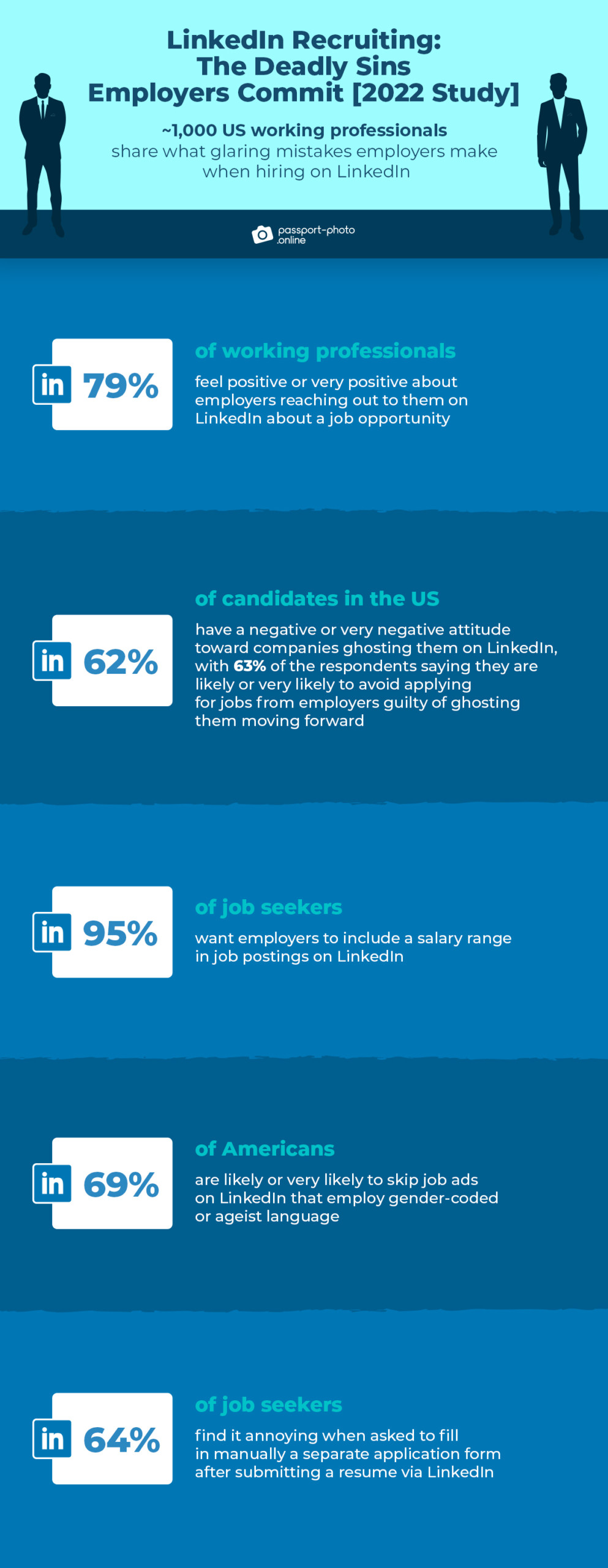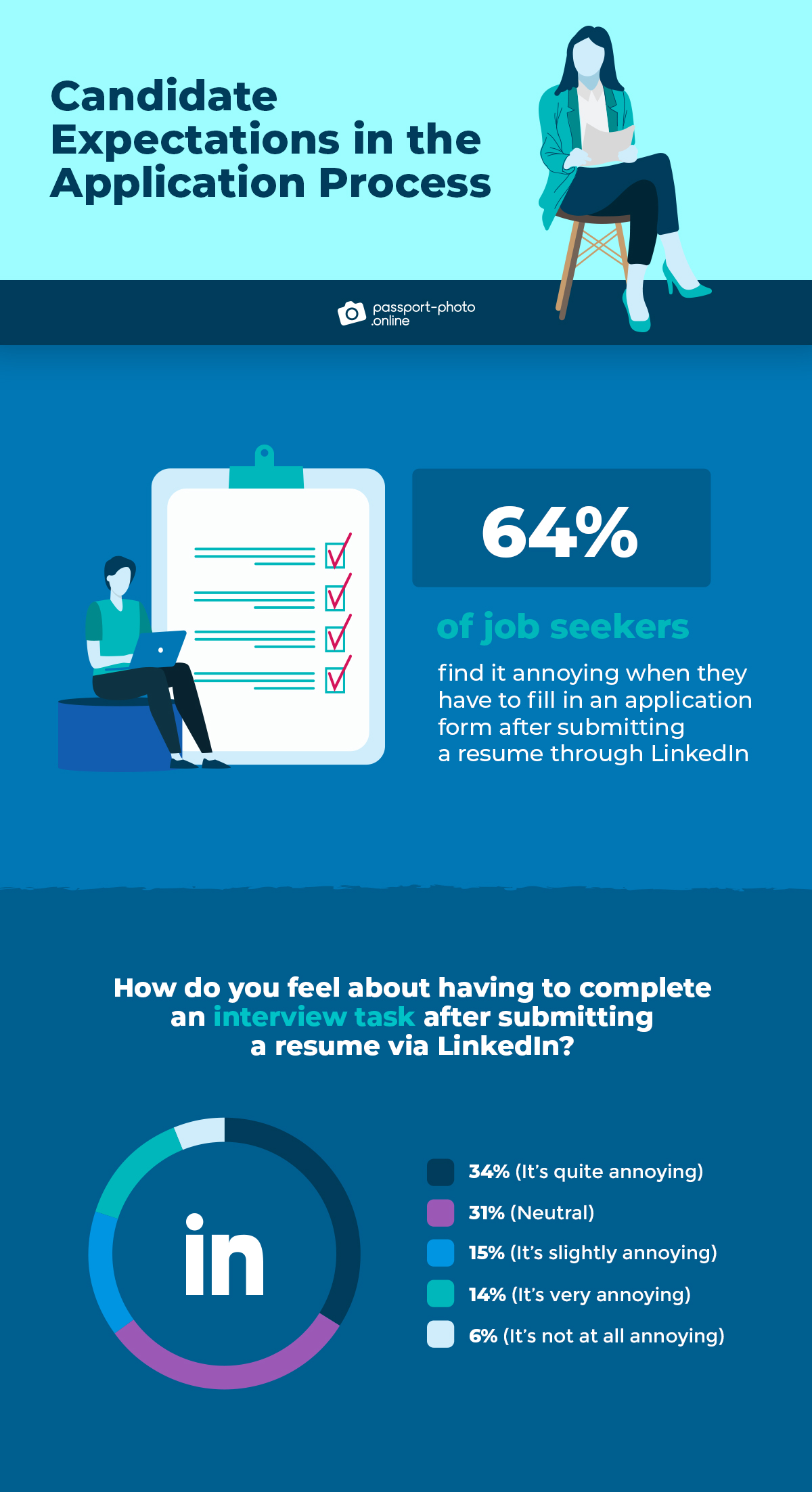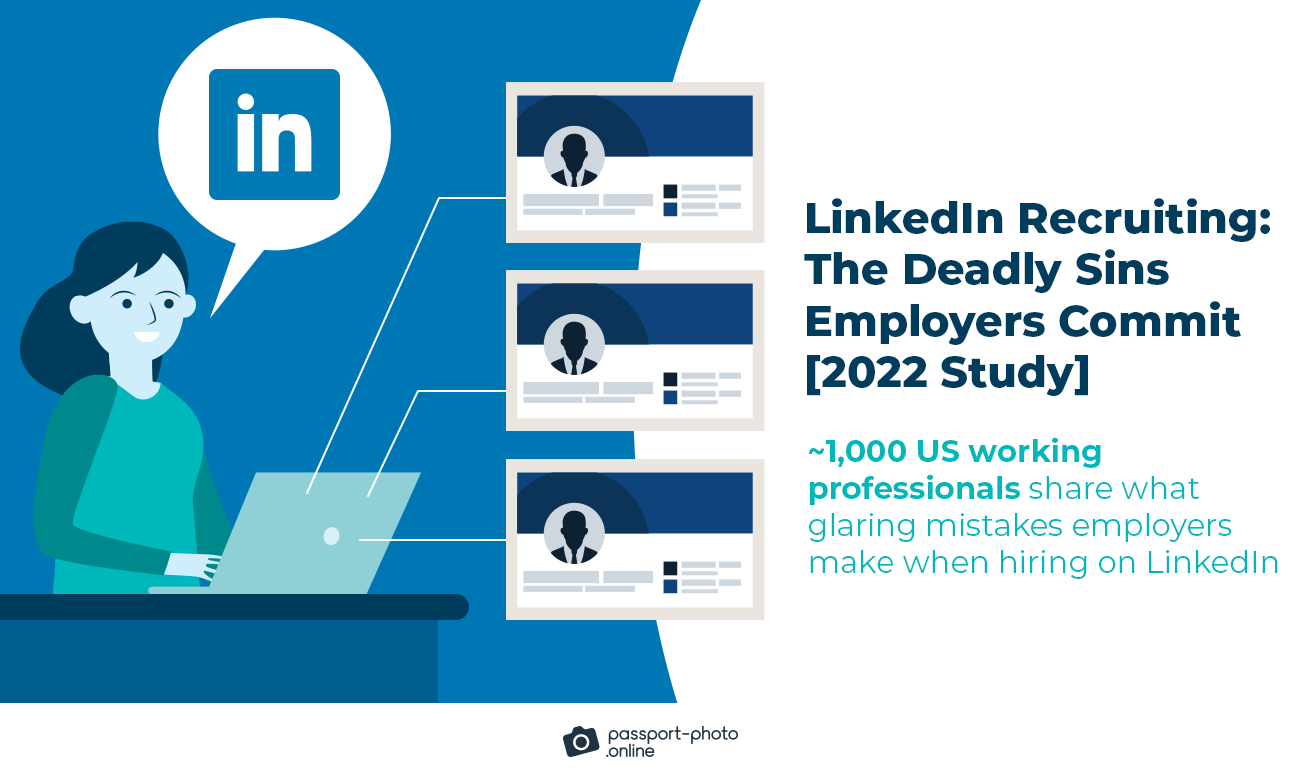Without a doubt, LinkedIn is the go-to place for sourcing golden-rip talent.
The problem?
It’s the job seeker’s market in 2022.
The US unemployment rate is at a steady 3.6% as of March. Plus, there are now 15M+ open job listings on LinkedIn, which means candidates can be picky.
So—
At Passport-Photo.Online, we’ve decided to poll ~1,000 US working professionals and uncover employers’ deadly mistakes when hiring on LinkedIn to help businesses recalibrate their recruitment efforts.
Key Takeaways

- Most working professionals (79%) feel positive or very positive about employers reaching out to them on LinkedIn about a job opportunity.
- A full 62% of candidates in the US have a negative or very negative attitude toward companies ghosting them on LinkedIn, with 63% saying they are likely or very likely to avoid applying for jobs from employers guilty of ghosting them moving forward.
- About 95% of job seekers want employers to include a salary range in job postings on LinkedIn.
- Roughly 69% of Americans are likely or very likely to skip job ads on LinkedIn that use gender-coded or ageist language.
- As many as 64% of job seekers find it annoying when asked to fill in manually a separate application form after submitting a resume via LinkedIn.
Candidate Outreach and Communication

Nod, if this sounds familiar:
You’re browsing through LinkedIn on the lookout for a new hire who will take your company to new heights.
At last, you come across your dream employee.
Based on their LinkedIn profile, the candidate is skilled, experienced, and will likely do the job of three.
So—
You decide to message them to see if they are open to work. That’s a smart move, as 79% of working professionals feel positive or very positive about employers reaching out to them on LinkedIn about a job opportunity, according to our study’s findings.
Five days later, your inbox is empty. Crickets.
But why?
That’s what we wanted to find out with our research first. So, we’ve pinpointed seven key reasons why US working professionals ignore LinkedIn recruiters’ messages about prospective employment:
- The message is too generic (a standard, templated blurb along the lines of “I’ve got the most amazing job I know you’ll love”): 58%
- The job opportunity doesn’t match the candidate’s experience level, skills, or career trajectory: 57%
- The company has a poor LinkedIn presence (e.g., it’s impossible to find sufficient information about the organization, its products or services, culture, or reviews): 55%
- The recruiter overuses buzzwords or corporate jargon: 52%
- There are grammatical mistakes in the outreach message: 51%
- The employer calls the candidate by the wrong name: 28%
- The organization comes off as disrespectful or too pushy: 26%
We then asked the survey takers what’s the maximum number of follow-ups they could tolerate from employers on LinkedIn.
Below are the results:
- Two: 39%
- One: 25%
- Three: 17%
- Four: 16%
- Zero: 4%
Lastly, we wanted to gauge job seekers’ attitudes toward employers ghosting them on LinkedIn (i.g., suddenly disappearing and no longer responding to messages).
Sadly, it’s become a common recruitment practice. So much so that 73% of employers openly admit they have ghosted a candidate in the past year, according to a recent Indeed study.
Somewhat predictably, our own research finds that 62% of job candidates in the US have a negative or very negative attitude toward companies ghosting them on LinkedIn. What’s more interesting, however, is that 63% of the respondents said they are likely or very likely to avoid applying for jobs from employers guilty of ghosting them in the future.
So—
Employers take note!

Do you need passport photos? Find out more:
The Deadly Sins of Job Description Writing on LinkedIn

Crafting a strong job ad is key.
Most candidates spend an average of 49.7 seconds on a job posting before clicking away. If you fail to grab their attention within that short window, you’ll likely lose a significant portion of applicants.
Hence, we’ve decided to ask candidates what job ad details employers must provide on LinkedIn to encourage them to apply. Below are the results:
- Job title: 69%
- Location: 62%
- Job summary (i.g., brief information about what the company does and the role): 61%
- Type of employment (remote, on-site, or hybrid): 58%
- Benefits: 58%
- Key duties: 54%
- Essential skills and experiences required: 53%
- Valuable extras/nice-to-haves: 42%
- Organizational values and culture: 28%
- Detailed-out application process: 13%
Now—
When we asked the survey takers if they think employers should also include a salary range in job postings, 95% said “Yes.” But there’s more. A full 69% of job seekers said they are likely or very likely to skip job ads on LinkedIn without a salary range.
That makes sense.
For one, it helps with pay transparency and ensures workers are paid equitably for equal work. Two, adding a job salary saves time, as it automatically skips candidates who won’t work in your pay range. Unfortunately, just 12% of job advertisements offer wage information, according to SHRM 2021 data.
Diving deeper into the survey results, we wanted to unearth how job seekers feel about employers on LinkedIn using terms like “superstar,” “Jedi,” or “rockstar” in job titles. It’s become common among companies looking to attract Millennials and Gen Zers, as they can arguably reframe how younger candidates think of the role and freshen a formal corporate image.
Below are the results:
- Positive: 48%
- Neutral: 22%
- Very positive: 16%
- Negative: 9%
- Very Negative: 6%
Generally, spicing up job titles is well-received across all the major demographics. Those 25-year-olds or younger and those aged 26–38 are particularly favorable of such terms, with 67% and 68%, respectively (vs. 64%) having a positive or very positive attitude toward rebranded titles.
Lastly, we wanted to see how job seekers feel about organizations using ageist or sexist language in job postings on LinkedIn, as both remain prevalent.
Words like “energetic,” “digital native,” or “recent college graduate,” even without harmful intent, can discourage older candidates from applying. Similarly, gendered wording like “assert” or “challenge” can be considered masculine and drive away female candidates.
So—here’s how Americans feel about ageist or sexist language in LinkedIn job ads:
- Negative: 47%
- Neutral: 20%
- Very Negative: 15%
- Positive: 9%
- Very positive: 10%
Moreover, 69% of the survey respondents said they are likely or very likely to skip job ads on LinkedIn that employ gender-coded or ageist language.
For this reason, employers may want to tap into the power of modern technology that can reveal hidden gender-specific words or ageist language and offer alternatives to make your LinkedIn job ads less biased and more inclusive.
Candidate Expectations in the Application Process

Let’s be honest:
More often than not, candidates have to jump through the hoops during the application process.
First, you have to spend a good hour or two tailoring a resume to a job description and pray the ATS (applicant tracking system) won’t throw your document in the trash.
Second, employers often ask candidates to manually fill in a separate application form after submitting a resume through LinkedIn. That’s something 64% of job seekers find annoying, our study finds.
Hence, it’s not surprising that another 60% of applicants will quit in the middle of filling out job applications due to their length or complexity, according to SHRM. In this context, it might be a good idea for employers to slash the time it takes to apply for a job and keep it under 15 minutes.
Lastly, there’s often an interview task candidates have to complete after submitting a resume. Here’s how US job seekers feel about such tasks:
- It’s quite annoying: 34%
- Neutral: 31%
- It’s slightly annoying: 15%
- It’s very annoying: 14%
- It’s not at all annoying: 6%
As you can see, most job seekers aren’t particularly happy about interview tasks.
That said, they are an essential step in the selection process, helping the employer determine if an applicant’s skills and experience meet the job’s requirements. To sweeten the pill, however, employers could provide monetary compensation for completed interview tasks, particularly time-consuming ones.
Methodology
We conducted an online survey of 991 US respondents via a bespoke online polling tool in April 2022. This study was created through multiple steps of research, crowdsourcing, and surveying. All survey participants’ responses were reviewed by data scientists for quality control. The survey had an attention-check question.
Fair Use Statement
Did our findings help you learn more about LinkedIn recruiting mistakes? If you believe your audience will be interested in this information, feel free to share it. Just remember to mention the source and link back to this page.
Sources
- Aslam S., “81 LinkedIn Statistics You Need to Know in 2022”
- Giang V., “Why You Keep Applying For The Wrong Jobs”
- Iacurci G., “4.3 Million People Quit Their Jobs in January as the Great Resignation Shows No Sign of Slowing Down”
- Maurer R., “More Employers Post Salary Ranges to Attract Workers”
- Premack R., “Companies Are Desperate to Attract Millennials — And They’re Rebranding Job Titles as ‘Ninjas,’ ‘Rock Stars,’ and ‘Evangelists’ to Do It”
- Statista, “Monthly Unemployment Rate in the United States from March 2021 to March 2022”
- Threlkeld K., “Employer Ghosting: A Troubling Workplace Trend”
- Zielinski D., “Study: Most Job Seekers Abandon Online Job Applications”

As a Digital PR specialist and a member of the Society of Professional Journalists (SPJ), Max has 5+ years of writing experience.
Over the course of his career, Max’s work has garnered significant attention, with features in numerous prominent publications such as The New York Times, Forbes, Inc., Business Insider, Fast Company, Entrepreneur, BBC, TechRepublic, Glassdoor, and G2.









